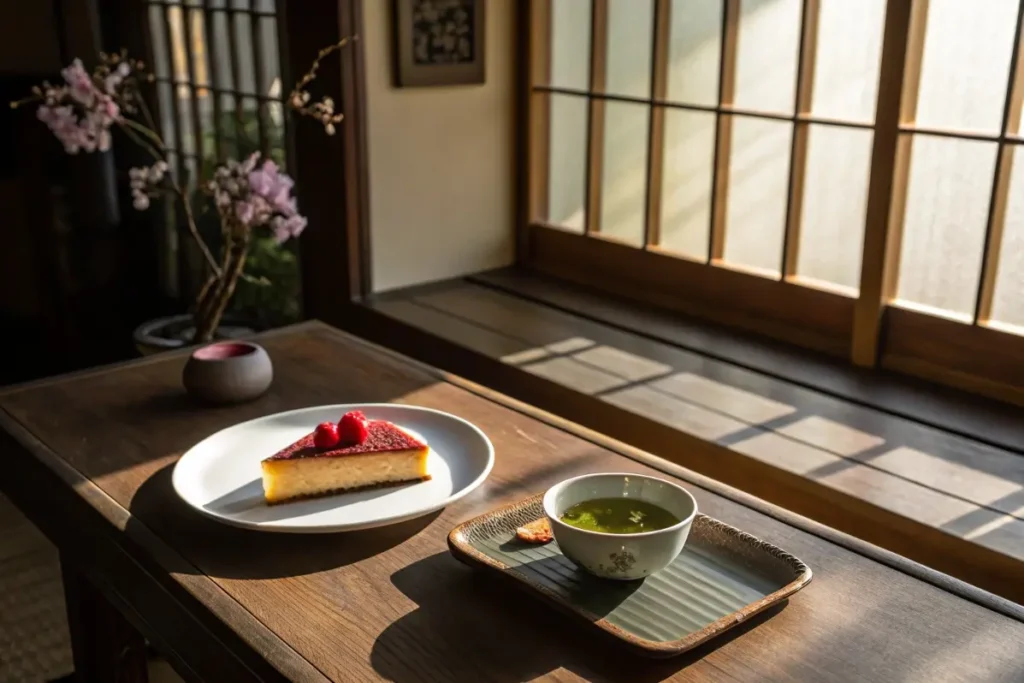The world of japanese jelly dessert is a realm of delicate textures, refreshing flavors, and vibrant colors. In Japan, jelly can take the form of kanten-based confections—firm yet pleasantly yielding, often combined with fruits or sweet beans—and mizu yokan, a gently sweet, jelly-like sweet bean treat. But what is the name of the Japanese jelly dessert? You might hear terms like “zerii” (a loanword for Western jelly) or “kanten desserts” when referring to agar-based sweets. Meanwhile, what is jelly called in Japan? Local confections often revolve around kanten rather than gelatin, harnessing the properties of seaweed-derived agar for a clean, delicate mouthfeel.
What is the famous dessert in Japan? Many point to mizu yokan, matcha jelly, or anmitsu (a bowl of jelly cubes, fruit, and sweet syrup) as iconic examples of Japanese Jelly Dessert. But these desserts aren’t just about taste; they embody Japan’s emphasis on seasonality, health-consciousness, and mindful eating. What is the jelly-like food in Japan? Beyond sweet jellies, you’ll find savory jelly forms in culinary traditions, but it’s the dessert variations—laced with sweet beans, fruit juices, or matcha—that truly capture the imagination as the quintessential Japanese Jelly Dessert.
Curious about making these translucent treats at home? Our Japanese Dessert Recipes collection offers a starting point for agar-based experiments, from fruity cups to elegant jelly cakes. Ready to dive deeper? In this comprehensive guide, we’ll explore essential ingredients, seasonal variations, cultural context, and more, giving you the confidence to bring these uniquely refreshing desserts into your own kitchen.
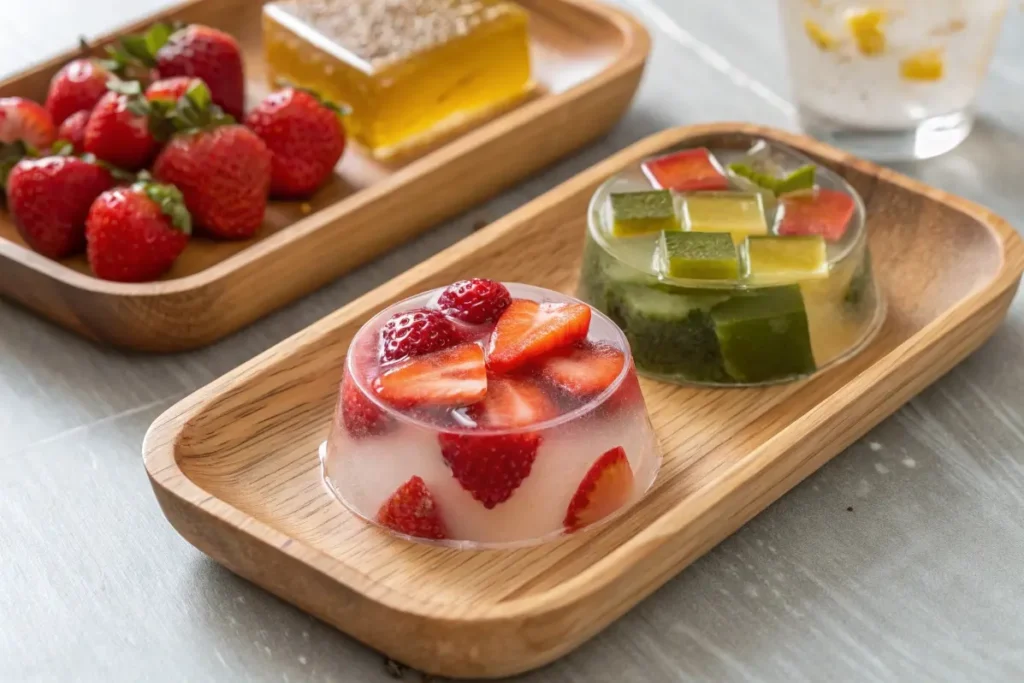
Table of Contents
1. Exploring the World of Japanese Jelly Desserts
1.1 What Defines a Japanese Jelly Dessert?
A japanese jelly dessert typically revolves around kanten, a seaweed-based gelling agent also known as agar-agar. Unlike animal-based gelatin, kanten sets at room temperature into a firmer texture and offers a cleaner, less “bouncy” feel. Alternatively, some modern sweets use standard gelatin or fruit pectin, but agar stands at the heart of classical Japanese jelly confections.
Common forms:
- Kanten Jelly Cups: Often layered with fruit slices or sweet bean paste, sealed into single-serving cups for convenience.
- Mizu Yokan: A denser, rectangular jelly block made with sweet azuki bean paste.
- Matcha or Coffee Jelly: Flavored with tea, coffee, or other aromatics for a refreshing pick-me-up in cafes.
1.2 Why Kanten?
Kanten’s popularity stems from a few factors:
- Vegetarian-Friendly: Derived from seaweed, it suits vegetarian or vegan diets.
- Higher Setting Temperature: It solidifies at room temperature, staying firm even in warm climates.
- Health Perks: Kanten is high in fiber and low in calories—particularly valued in Japan’s health-conscious food culture.
1.3 Texture and Flavor
What is the jelly-like food in Japan? The texture is typically firmer than Western gelatin—some describe it as slightly brittle yet smooth. Flavor can be mild on its own, so sweeteners, fruit juices, or sweet bean paste (anko) provide taste. People often use syrups or condensed milk drizzles for extra sweetness or visual appeal.
Long-Tail Keywords to Note:
- japanese jelly cups
- fruit with jelly
- fruit jelly recipe
- kanten jelly
- anmitsu dessert
1.4 Seasonal Variations
Summer is prime time for chilled jelly sweets. Many shops showcase anmitsu, a chilled dessert of agar cubes, sweet beans, fruit, and black sugar syrup (kuromitsu). In contrast, cooler seasons might favor heartier jellies combined with anko or chestnuts. Some places even craft autumn-themed jelly desserts with kabocha (Japanese pumpkin) or sweet potato, bridging the gap between savory produce and sweet treats.
1.5 Pairing Jelly Desserts with Teas and Meals
Jelly desserts often appear at the tail end of a meal, especially in kaiseki or formal dining. They cleanse the palate with minimal sugar. A matcha or hoji-cha beverage complements the subtle sweetness of jelly, matching the dessert’s refreshing nature. For a contrast of flavor and temperature, some enjoy pairing cold jelly with hot tea or warm red bean soup.
Looking for a savory-sweet pairing? Browse our Japanese Chicken Fried Rice Recipe for a robust main, followed by a light jelly dessert. This balanced approach is deeply ingrained in Japanese dining, ensuring each meal’s end is satisfying but never heavy.
1.6 The Modern Jelly Scene
Beyond traditional jelly blocks, contemporary cafes experiment with layered fruit purées, milky layers, or even sparkling wine–infused gels for a trendy spin. Some prefer “floaters”—small gelatin spheres floating in beverages or served with fresh fruit. The consistent theme remains: highlighting fresh flavors, moderate sweetness, and an aesthetically pleasing form that respects the minimalistic Japanese style.
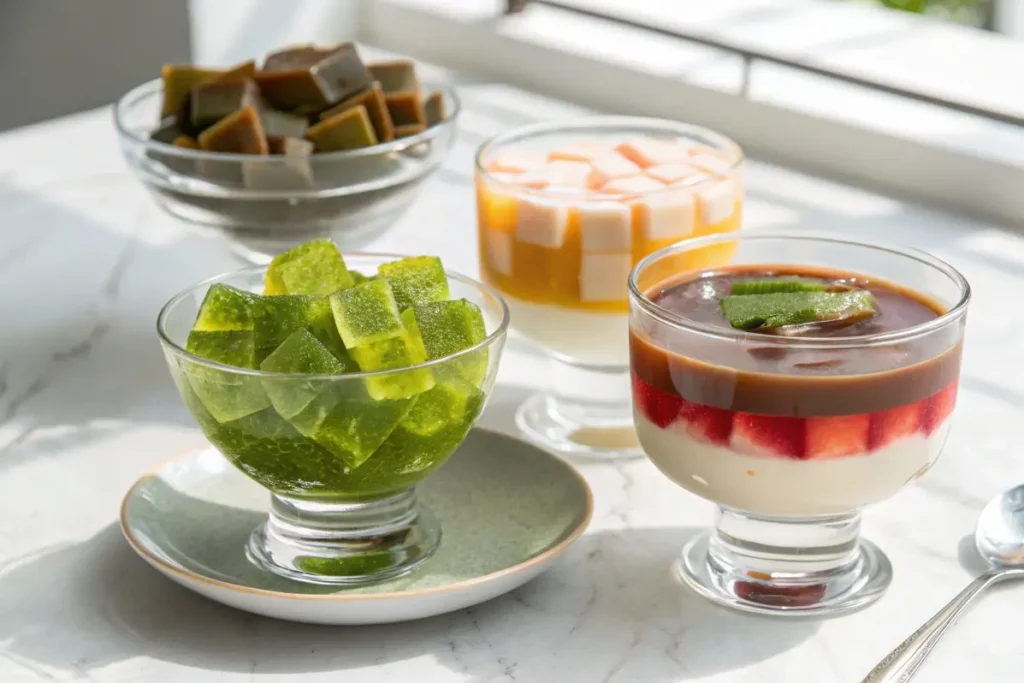
2. Essential Ingredients and Tools for Japanese Jelly Desserts
2.1 Kanten (Agar-Agar)
Kanten—a seaweed extract—forms the backbone of many japanese jelly dessert recipes. Sold in bars, flakes, or powder, it dissolves in hot water, then gels upon cooling. Kanten yields a firmer texture than gelatin, ideal for cutting into cubes or slices.
Cooking Tips:
- Dissolve Thoroughly: Stir continuously to avoid lumps.
- Measure Precisely: Kanten sets more solid than gelatin, so small measurement tweaks can alter texture significantly.
- Add Sweeteners Post-Dissolution: Many chefs mix sugar or sweet beans after the kanten is fully dissolved, ensuring uniform sweetness.
2.2 Azuki Bean Paste (Anko)
Used in desserts like mizu yokan or anmitsu, sweet bean paste provides earthy sweetness. If you enjoy a stronger bean flavor, choose tsubuan (chunky paste). For a smoother mouthfeel, koshian is your go-to. Check out our Anko Japanese Dessert guide for bean paste specifics.
2.3 Matcha Powder
For green tea jelly or layers in fruit jellies, matcha adds a subtle bitterness that counters sugar. Sift matcha first to prevent clumps, whisking it into a small portion of water before combining with the larger jelly solution.
2.4 Fruit Components
Fruit with jelly is a hallmark of Japanese dessert cups—fresh strawberries, peaches, or mandarins suspended in translucent agar. The fruit’s brightness complements the jelly’s mildness. Citrus fruit segments offer tangy contrast, while sweet grapes or melon cubes provide a summery accent.
Seasonal Fruit:
- Spring: Strawberries, cherries.
- Summer: Peaches, watermelons, and lychee.
- Autumn: Persimmons, figs.
- Winter: Mikan (mandarin orange).
2.5 Sweeteners and Syrups
Though many jellies remain lightly sweet, adding sugar or syrups like kuromitsu (Japanese black sugar syrup) can intensify flavor. Condensed milk often drizzled over matcha or coffee jelly yields a creamy indulgence. Some health-conscious variations use honey or stevia, maintaining minimal sugar.
2.6 Tools: Molds, Bowls, Ladles
- Molds: Standard rectangular pans for mizu yokan or ring molds for round jellies.
- Measuring Cups & Scales: Precision is crucial with agar, so weigh or measure carefully.
- Silicone Spatulas & Ladles: Gentle stirring ensures agar dissolves thoroughly and fruit pieces distribute evenly.
2.7 The Role of Water Hardness
Interestingly, the hardness of your water can affect agar’s setting strength. Slightly harder water might lead to firmer jelly. If you find your jellies too stiff or brittle, adjust water softness or reduce the agar quantity slightly.
For more advanced tips on sweeteners or flavor combos, see our Healthy Japanese Recipes which discuss sugar substitutions and mindful cooking approaches. Incorporating fruit juices or natural sweeteners can yield a lighter, more refreshing dessert, aligning with Japan’s minimalistic sweet ethos.
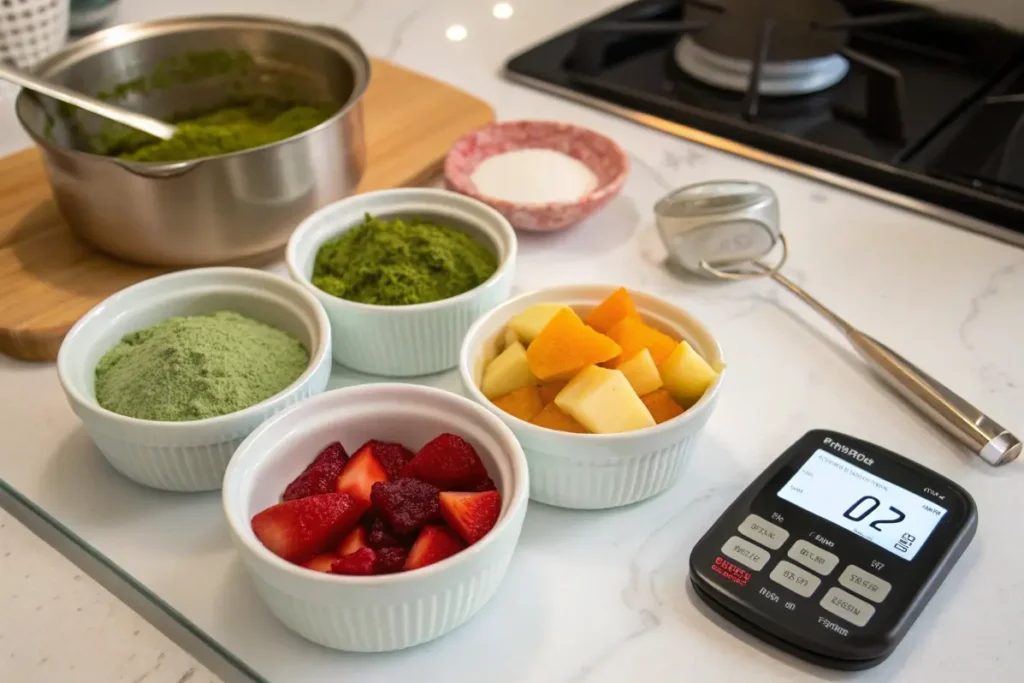
3. History and Context of Japanese Jelly Desserts
3.1 Kanten’s Early Discovery
Kanten has roots in Edo-period Japan. Folklore suggests that a traveling monk discovered agar’s gelling properties after leaving leftover seaweed soup outside in winter. Once recognized, agar usage spread for its shelf stability and vegetarian aspect—particularly appealing to Buddhist communities that minimized animal products.
3.2 From Temple to Teahouse
With sugar trade booming in the Edo era, sweet bean confections and agar-based jellies gained traction in large urban centers. Tea houses offered small jellied sweets to complement matcha’s bitter profile, refining the aesthetics and consistency of agar-based jellies. Over time, these jellies’ translucent beauty and mild flavor found broad appreciation.
3.3 Influence of Western Jelly and Technology
Post-1868, Western “gelatin-based” desserts also arrived, but many Japanese chefs stuck to agar for climate and cultural reasons. Refrigeration technology improved in the 20th century, popularizing chilled fruit jellies, coffee jellies, and layer cakes. Confectioners saw jelly desserts as an easy way to incorporate seasonal fruit flavors or even alcohol infusions while maintaining a sophisticated look.
3.4 Anmitsu and Mizu Yokan
Anmitsu (a bowl of agar cubes, anko, fruit, and syrup) epitomizes summer refreshment. Typically served in glass bowls to highlight color, it soared in popularity during the Showa era. Meanwhile, mizu yokan—a simpler, rectangular block of sweet bean jelly—remains a timeless staple. Some families freeze yokan to enjoy it partially thawed on scorching days, showcasing the versatility of agar-based sweets.
3.5 Contemporary Twists
Present-day patisseries and restaurants continuously reinvent japanese jelly dessert. Layered parfait cups containing matcha jelly, whipped cream, and mochi balls appeal to social media-savvy diners. Experimental chefs incorporate exotic fruits or savory elements like subtle miso or black pepper. The core principle remains: highlight agar’s texture, delicate sweetness, and aesthetic minimalism.
Global Reach: As Japanese cuisine garners worldwide fans, the idea of a fruit jelly recipe or green tea–flavored jelly dessert gains traction abroad. People appreciate agar’s vegetarian credentials and the healthy profile of fruit-laden sweets. Western grocery stores increasingly stock agar or “kanten,” encouraging a new wave of home cooks to attempt these distinct jellies.
For a deeper exploration of how other Japanese sweets have shaped modern dessert culture, see our Famous Japanese Desserts reference, highlighting the interplay between tradition and innovation. Ultimately, the history of japanese jelly dessert reveals a versatile treat that evolves with each generation, reflecting seasonal bounty, healthful practices, and a refined sense of presentation.
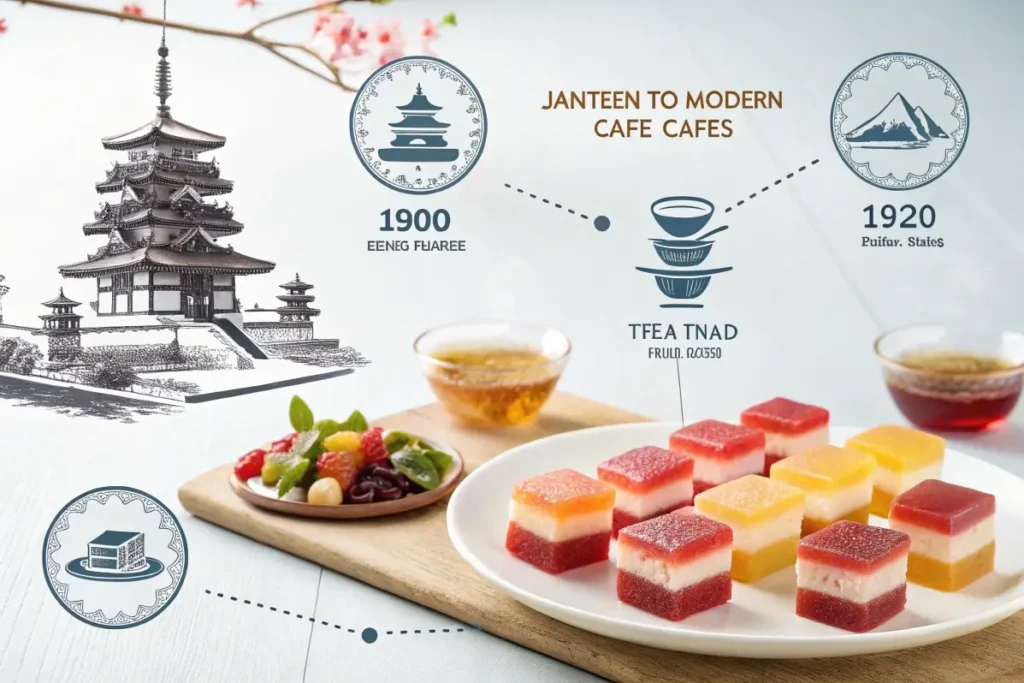
4. Practical Examples/Use Cases
4.1 Home Dessert Party
Scenario: Hosting a Japanese-themed dinner.
- Approach: Serve a trifecta of mini jelly cups—matcha jelly layered with sweet bean paste, fruit-infused kanten with strawberry slices, and coffee jelly topped with whipped cream.
- Result: Guests enjoy variety in taste and color. Each cup can be prepared in advance and kept refrigerated, simplifying last-minute hosting stress.
4.2 Bakery or Cafe Special
Scenario: A local bakery wants a refreshing, health-friendly addition to its menu.
- Approach: Introduce single-serving kanten cups with fresh fruit cubes or swirl in some anko for a sweet-savory dynamic. Advertise them as “low-calorie,” “vegetarian,” or “summer-friendly.”
- Benefit: Attract health-conscious customers, plus add an exotic flair that sets your bakery apart from standard Western fare.
4.3 Bento and Office Snacks
Scenario: You prefer a light, convenient sweet treat without heavy sugar.
- Approach: Prepare small jelly blocks or layered jelly squares over the weekend—like a fruit jelly recipe with minimal sugar. Slice them into bite-size cubes, store in sealed containers.
- Advantage: Perfect for slipping into a lunch box or enjoying at your office break. Agar’s firmness means they hold shape even at mild room temperatures, as long as they’re not in extreme heat.
4.4 Summer Picnic or Potluck
Scenario: You’re invited to a potluck and want a visually striking dessert.
- Approach: Craft a big fruit jelly ring using agar: layer bright strawberries, kiwi, peaches, or mandarin segments in a ring mold. Pour lightly sweetened agar mixture. Chill until firm. Turn it out onto a serving platter.
- Upshot: Vibrant color, easy portioning, and a refreshing taste that stands out among typical cakes or cookies.
If you’re seeking more ways to incorporate sweeteners or local produce, you can explore Vegetables Japanese Recipe ideas—some vegetable-based broths or fruit combos might inspire unique twists for your jellies, merging savory, sweet, or tangy profiles. These real-life uses show how japanese jelly dessert aligns well with modern living, from simple homemade options to premium cafe showcases.
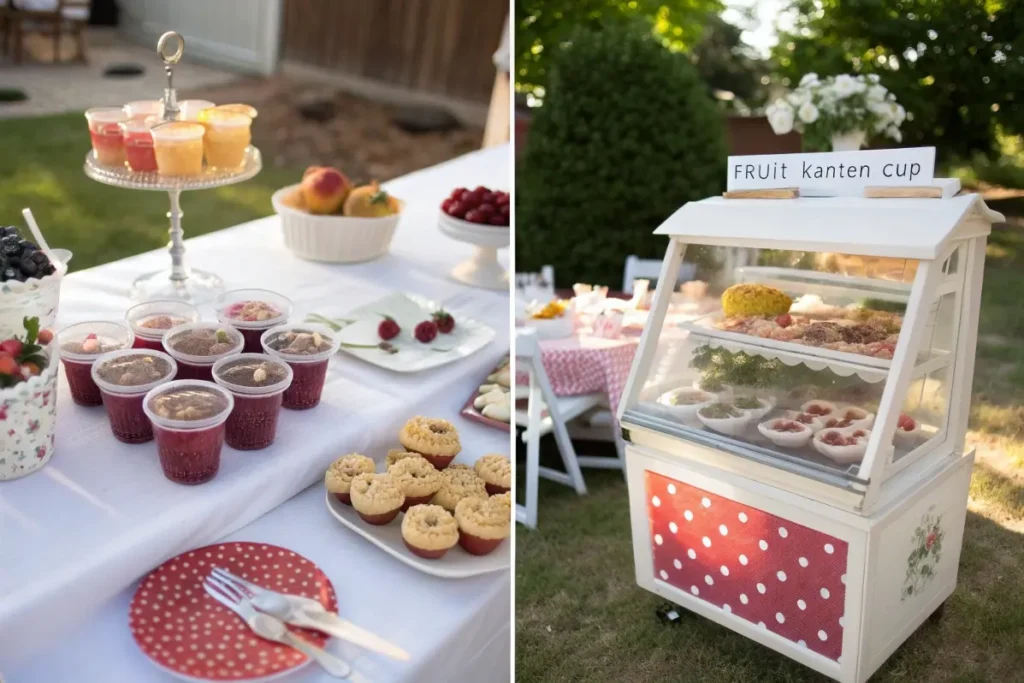
5. FAQs about Japanese Jelly Dessert
5.1 What is the name of the Japanese jelly dessert?
Many refer to it broadly as a “kanten-based dessert” or “zerii,” the loanword for Western jelly. However, specific names include “anmitsu” (agar cubes with fruit and anko) or “mizu yokan” (bean-based jelly). Each differs slightly in ingredient composition but falls under the japanese jelly dessert category.
5.2 What is jelly called in Japan?
In everyday usage, “ゼリー (zerii)” references Western-style gelatin desserts. For agar-based treats, “kanten” is more accurate. Wagashi shops generally label their jellies as yokan or kanten zeri, distinguishing them from typical gelatin sweets.
5.3 What is the famous dessert in Japan?
There’s no single definitive answer—mochi, dorayaki, and matcha parfait are all strong contenders. But as for jelly specifically, mizu yokan and anmitsu rank highly. Both use agar to create a fresh, subtly sweet taste that pairs well with Japanese teas.
5.4 What is the jelly-like food in Japan?
Beyond sweet desserts, you might see “konnyaku” (konjac jelly) in savory contexts. But for sweets, “kanten-based jelly” or “mizu yokan” typically come to mind. These jellies leverage agar’s plant-based properties for a firmer set and mild flavor.
5.5 Are Japanese jellies healthier than Western gelatin desserts?
Agar is high in fiber, sugar usage often remains moderate, and many recipes feature real fruit or natural flavors. However, sugar levels vary by recipe. Overall, japanese jelly dessert can be a lighter alternative, especially if you watch portion sizes or opt for low-sugar fruit additions.
5.6 Can I replicate them at home easily?
Yes. Agar is widely available in Asian groceries or online. Basic recipes involve dissolving agar in water, then adding sweeteners, flavors, or fruit. Chill until set. For more advanced shapes, layered effects, or sweet bean additions, see our Traditional Japanese Desserts Recipe for step-by-step guidance.
5.7 Does the climate affect agar-based jellies?
Agar sets even at room temperature, so they hold form well in warm weather—ideal for summer. Just avoid extremely high temps or direct sunlight, which could cause partial melting. Still, these jellies remain more stable than gelatin counterparts in similar conditions.
Conclusion for Japanese Jelly Dessert
Whether you opt for a mizu yokan block, fruit-layered cups, or a summertime bowl of anmitsu, the japanese jelly dessert universe delivers delicate textures and refreshing tastes. You’ll find agar-based confections championing subtle sweetness and minimalistic elegance—trademarks of Japanese culinary ethos. From kanten extraction in the Edo period to modern fruit-laden parfaits, these jellies continuously evolve while staying true to their light, refined character.
Interested in experimenting? Stock up on agar powder, fresh fruit, or azuki bean paste. Start with simpler fruit jelly cups or a matcha-infused jelly for an easy introduction. As you grow confident, explore layering multiple colors or weaving sweet bean paste into the mix. For more advanced guidance, check our Japanese Dessert Recipes to discover step-by-step instructions for elaborate jelly artistry.
Ultimately, japanese jelly dessert is about balance—balancing the natural flavors of fruit or tea with just enough sweetness, balancing tradition with creative flair, and balancing the restful pleasure of a gently set jelly with the excitement of fresh innovation. Try these confections at home or seek them out in specialty shops, and experience a slice of Japan’s refreshing sweet culture in every translucent bite.
